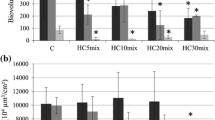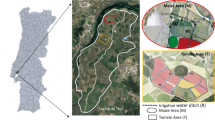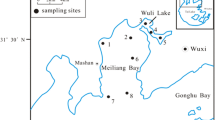Abstract
Mixture risk assessment predictions have rarely been confronted with biological changes observed in the environment. In this study, long-term monitoring of a European great lake, Lake Geneva, provides the opportunity to assess to what extent the predicted toxicity of herbicide mixtures explains the changes in the composition of the phytoplankton community next to other classical limnology parameters such as nutrients. To reach this goal, the gradient of the mixture toxicity of 14 herbicides regularly detected in the lake was calculated using concentration addition and response addition models. A temporal gradient of toxicity was observed which decreased from 2004 to 2009. Redundancy analysis and partial redundancy analysis showed that this gradient explains a significant portion of the variation in phytoplankton community composition with and without having removed the effect of all other co-variables. Moreover, species that are significantly influenced, positively or negatively, by the decrease of toxicity in the lake over time are highlighted. It can be concluded that the herbicide mixture toxicity is one of the key parameters to explain phytoplankton changes in Lake Geneva.




Similar content being viewed by others
References
AGRITOX (2012) Database for pesticides. http://www.dive.afssa.fr/agritox/index.php. Accessed August 2011
Altenburger R, Backhaus T, Boedeker W, Faust M, Scholze M, Horst Grimme L (2000) Predictability of the toxicity of multiple chemical mixtures to Vibrio fischeri: mixtures composed of similarly acting chemicals. Environ Toxicol Chem 19(9):2341–2347. doi:10.1002/etc.5620190926
Anneville O, Ginot V, Druart JC, Angeli N (2002) Long-term study (1974–1998) of seasonal changes in the phytoplankton in Lake Geneva: a multi-table approach. J Plankton Res 24(10):993–1008. doi:10.1093/plankt/24.10.993
Barnthouse L (2008) The strengths of the ecological risk assessment process: linking science to decision making. Integr Environ Assess Manage 4(3):299–305. doi:10.1897/IEAM_2007-065.1
Beketov MA, Liess M (2011) Ecotoxicology and macroecology: time for integration. Environ Pollut 162:247–254. doi:10.1016/j.envpol.2011.11.011
Bérard A, Benninghoff C (2001) Pollution-induced community tolerance (PICT) and seasonal variations in the sensitivity of phytoplankton to atrazine in nanocosms. Chemosphere 45(4–5):427–437. doi:10.1016/S0045-6535(01)00063-7
Bérard A, Leboulanger C, Pelte T (1999a) Tolerance of Oscillatoria limnetica Lemmermann to Atrazine in natural phytoplankton populations and in pure culture: influence of season and temperature. Arch Environ Contam Toxicol 37(4):472–479. doi:10.1007/s002449900541
Bérard A, Pelte T, Druart JC (1999b) Seasonal variations in the sensitivity of Lake Geneva phytoplankton community structure to atrazine. Archiv für Hydrobiologie 145(3):277–295
Bérard A, Dorigo U, Mercier I, Becker-Van Slooten K, Grandjean D, Leboulanger C (2003) Comparison of the ecotoxicological impact of the triazines Irgarol 1051 and atrazine on microalgal cultures and natural microalgal communities in Lake Geneva. Chemosphere 53(8):935–944. doi:10.1016/S0045-6535(03)00674-X
Chatterjee S, Hadi AS (2006) Regression analysis by example, 4th edn. Wiley., Hoboken
Chèvre N, Gregorio V (2012) Interactions in ecotoxicology. In: Blaise C, Ferrard JF (eds) Comprehensive handbook of ecotoxicological terms, Elsevier, New York (In press)
Chèvre N, Loepfe C, Singer H, Stamm C, Fenner K, Escher B (2006) Including mixtures in the determination of water quality criteria for herbicides in surface water. Environ Sci Technol 40(2):426–435. doi:10.1021/es050239l
Chèvre N, Loepfe C, Fenner K, Singer H, Escher B, Stamm C (2007) Pesticides in Swiss surface water : effect-based quality criteria. Gas Wasser Abwasser 7:529–539
Chèvre N, Edder P, Ortelli D, Tatti E, Erkman S, Rapin F (2008) Risk assessment of herbicide mixtures in a large European lake. Environ Toxicol 23(2):269–277. doi:10.1002/tox.20337
Corvi C, Zimmerli P, Ortelli D, Khim-Heang S, Becker-Van Slooten K (2005) Metals and micropollutants in the water, mussels and fish of lake Geneva. Report from CIPEL Campaign 2004, Changins, pp 55–78
de Zwart D, Posthuma L (2005) Complex mixture toxicity for single and multiple species: proposed methodologies. Environ Toxicol Chem 24(10):2665. doi:10.1897/04-639R.1
Debenest T, Silvestre J, Coste M, Pinelli E (2010) Effects of pesticides on freshwater diatoms. Rev Environ Contam Toxicol 203:87–103. doi:10.1007/978-1-4419-1352-4_2
Druart JC (2007) The phytoplankton of lake Geneva. Report from CIPEL Campaign 2006, Changins, pp 83–92
Druart JC, Rimet F (2008) Protocoles d’analyse du phytoplancton de l’INRA : prélèvement, dénombrement et biovolumes. Report from INRA, Thonon les Bains
Druart JC, Rolland A, Tadonleke R (2005) Changes in the phytoplankton of lake Geneva. Report from CIPEL Campaign 2004, Changins, pp 79–89
Druart JC, Robert M, Tadonleke R (2006) The phytoplankton of lake Geneva. Report from CIPEL Campaign 2005, Changins, pp 89–100
eChemPortal (2011) The global portal to information on chemical substances. http://www.echemportal.org. Accessed August 2011
ECOTOX (2012) The ecotoxicology database, U.S. Environmental Protection Agency. http://cfpub.epa.gov/ecotox. Accessed August 2011
Edder P, Ortelli D, Ramseier S (2006) Metals and organic micropollutants. Report from CIPEL Campaign 2005, Changins, pp 65–87
Edder P, Ortelli D, Ramseier S, Chèvre N (2007) Metals and organic micropollutants in Geneva lake waters. Report from CIPEL Campaign 2006, Changins, pp 59–81
Edder P, Ortelli D, Klein A, Ramseier S (2008) Metals and organic micropollutants in Geneva lake waters and sediments. Report form CIPEL Campaign 2007, Changins, pp 57–84
EFSA (2012) European Food Safety Authority. http://www.efsa.europa.eu/en/publications.htm. Accessed August 2011
EN 15204 (2006) Water quality: guidance standard on the enumeration of phytoplankton using inverted microscopy (Utermöhl Technique). European Committee for Standardization, Brussels
European Commission (2003) Technical guidance document on risk assessment TGD. Part II. Institute for health and consumer protection, European Chemicals Bureau, European Commission (EC), Ispra
Faust M, Altenburger R, Backhaus T, Blanck H, Boedeker W, Gramatica P, Hamer V, Scholze M, Vighi M, Horst Grimme L (2003) Joint algal toxicity of 16 dissimilarly acting chemicals is predictable by the concept of independent action. Aquat Toxicol 63(1):43–63. doi:10.1016/S0166-445X(02)00133-9
FOOTPRINT (2010) Functional tools for pesticide risk assessment and management. http://www.eu-footprint.org/ppdb.html. Accessed August 2011
Hari RE, Livingstone DM, Siber R, Burkhardt-Holm P, Guttinger H (2006) Consequences of climatic change for water temperature and brown trout populations in Alpine rivers and streams. Glob Change Biol 12:10–26. doi:10.1111/j.1365-2486.2005.001051.x
INERIS (2012) Institut national de l’environnement industriel et des risques. http://www.ineris.fr. Accessed August 2011
Junghans M, Backhaus T, Faust M, Scholze M, Horst Grimme L (2003) Predictability of combined effects of eight chloroacetanilide herbicides on algal reproduction. Pest Manag Sci 59(10):1101–1110. doi:10.1002/ps.735
Kendall M (1955) Rank correlation methods, 2nd edn. Charles Griffin, London
Knauer K, Leimgruber A, Hommen U, Knauert S (2010) Co-tolerance of phytoplankton communities to photosynthesis II inhibitors. Aquat Toxicol 96(4):256–263. doi:10.1016/j.aquatox.2009.11.001
Kortenkamp A (2011) Setting the scene: is mixtures risk assessment necessary and feasible? 3rd SETAC Europe special science symposium, prospective and retrospective environmental risk assessment of mixtures: moving from research to regulation, Brussels
Kutner M, Nachtsheim C, Neter J (2004) Applied linear regression models, 4th edn. McGraw-Hill, New York
Lazzarotto J, Rapin F (2007) Physical-chemical changes in the waters of lake Geneva. Report from CIPEL Campaign 2006, Changins, pp 33–57
Lazzarotto J, Rapin F (2008) Physical-chemical changes in the waters of lake Geneva. Report from CIPEL Campaign 2007, Changins, pp 31–55
Lazzarotto J, Rapin F (2009) Physical-chemical changes in the waters of lake Geneva. Report from CIPEL Campage 2008, Changins, pp 33–58
Lazzarotto J, Rapin F (2010) Physical-chemical changes in the waters of lake Geneva. Report from CIPEL Campaign 2009, Chanings, pp 31–56
Lazzarotto J, Rapin F, Corvi C (2005) Physical-chemical changes in the waters of lake Geneva. Report from CIPEL Campaign 2004:31–53
Lazzarotto J, Nirel P, Rapin F (2006) Physical-chemical changes in the waters of lake Geneva. Report from CIPEL Campaign 2005, Changins, Switzerland, pp 31-63 (in french)
Legendre P, Gallagher E (2001) Ecologically meaningful transformations for ordination of species data. Oecologia 129:271–280. doi:10.1007/s004420100716
Legendre P, Legendre L (1998) Numerical ecology, 2nd edn. Elsevier Science B.V, Amsterdam
Loos R, Gawlik BM, Locoro G, Rimaviciute E, Contini S, Bidoglio G (2009) EU-wide survey of polar organic persistent pollutants in European river waters. Environ Pollut 157(2):561–568. doi:10.1016/j.envpol.2008.09.020
Mann HB (1945) Nonparametric tests against trend. Econometrica 13(3):245–259
McClellan K, Altenburger R, Schmitt-Jansen M (2008) Pollution-induced community tolerance as a measure of species interaction in toxicity assessment. J Appl Ecol 45(5):1514–1522. doi:10.1111/j.1365-2664.2008.01525.x
Nyström B, Becker-Van Slooten K, Bérard A, Grandjean D, Druart JC, Leboulanger C (2002) Toxic effects of Irgarol 1051 on phytoplankton and macrophytes in Lake Geneva. Water Res 36(8):2020–2028. doi:10.1016/S0043-1354(01)00404-3
OPP (2012) Pesticide ecotoxicity database. Integrated pest management. http://www.ipmcenters.org/Ecotox/dataaccess.cfm. Accessed August 2011
Ortelli D, Edder P, Rapin F, Ramseier S (2009) Metals and organic micropollutants in Geneva lake waters. Report from CIPEL Campaign 2008, Changins, pp 59–71
Ortelli D, Edder P, Rapin F, Ramseier S (2010) Metals and organic micropollutants in rivers and Geneva lake waters. Report from CIPEL Campaign 2009, Changins, pp 57–76
Padisák J, Hajnal E, Krienitz L, Lakner J, Üveges V (2010) Rarity, ecological memory, rate of floral change in phytoplankton—and the mystery of the Red Cock. Hydrobiologia 653(1):45–64. doi:10.1007/s10750-010-0344-2
Pannard A, Rouzic B, Binet F (2008) Response of phytoplankton community to low-dose atrazine exposure combined with phosphorus fluctuations. Arch Environ Contam Toxicol 57:50–59. doi:10.1007/s00244-008-9245-z
Pesce S, Bouchez A, Montuelle B (2011) Effects of organic herbicides on phototrophic microbial communities in freshwater ecosystems. Rev Environl Contam Toxicol 214:87–124. doi:10.1007/978-1-4614-0668-6_5
Posthuma L, De Zwart D (2006) Predicted effects of toxicant mixtures are confirmed by changes in fish species assemblages in Ohio, USA, rivers. Environ Toxicol Chem 25(4):1094–1105. doi:10.1897/05-305R.1
Posthuma L, Suter GWI, Traas TP (2002) Species sensitivity distributions in ecotoxicology. Lewis Publishers, Boca Raton
Redfield AC (1958) The biological control of chemical factors in the environment. Am Sci 46(3):205–221
Ricart M, Barceló D, Geiszinger A, Guasch H, López de Alda M, Romaní AM, Vidal G, Villagrasa M, Sabater S (2009) Effects of low concentrations of the phenylurea herbicide diuron on biofilm algae and bacteria. Chemosphere 76(10):1392–1401. doi:10.1016/j.chemosphere.2009.06.017
Rimet F (2010) The phytoplankton of lake Geneva. Report from CIPEL Campaign 2009, Changins, pp 77–88
Rimet F, Druart JC (2009) The phytoplankton of lake Geneva. Report from CIPEL Campaign 2008, Changins, pp 91–102
Rimet F, Druart JC, Moreau L (2008) The phytoplankton of lake Geneva. Report from CIPEL Campaign 2007, Changins, pp 85–95
Rimet F, Druart JC, Anneville O (2009) Exploring the dynamics of plankton diatom communities in Lake Geneva using emergent self-organizing maps (1974–2007). Ecol Inf 4:99–110. doi:10.1016/j.ecoinf.2009.01.006
Schwarzenbach RP, Escher BI, Fenner K, Hofstetter TB, Johnson CA, von Gunten U, Wehrli B (2006) The challenge of micropollutants in aquatic systems. Science 313:1072–1077. doi:10.1126/science.1127291
Tadonléké RD, Lazzarotto J, Anneville O, Druart JC (2009) Phytoplankton productivity increased in Lake Geneva despite phosphorus loading reduction. J Plankton Res 31(10):1179–1194. doi:10.1093/plankt/fbp063
R Development Core Team (2009) R: A language and environment for statistical computing. R Foundation for Statistical Computing, Vienna, Austria. http://www.R-project.org
Van den Brink PJ, Rubach MN, Culp JM, Pascoe T, Maund SJ, Baird DJ (2011) Traits-based ecological risk assessment (TERA): realizing the potential of ecoinformatics approaches in ecotoxicology. Integr Environ Assess Manage 7(2):169–171. doi:10.1002/ieam.103
Ward S, Augspurger T, Dwyer FJ, Kane C, Ingersoll CG (2007) Risk assessment of water quality in three North Carolina, USA, streams supporting federally endangered freshwater mussels (unionidae). Environ Toxicol Chem 26(10):2075–2085. doi:10.1897/06-561R.1
Williams RJ, Keller VDJ, Johnson AC, Young AR, Holmes MGR, Wells C, Gross-Sorokin M, Benstead R (2009) A national risk assessment for intersex in fish arising from steroid estrogens. Environ Toxicol Chem 28(1):220–230. doi:10.1897/08-047.1
Acknowledgments
This project is part of the FNS Prodoc Project Leman21. The authors want to acknowledge the Swiss National Science Foundation (Grant number PDFMP2-123048/1) and the Ministère français de l’Ecologie, de l’Energie, du Développement Durable et de l’Aménagement du Territoire (convention 2100212555) for funding this study. The data used in this study were kindely provided by the CIPEL (The International Commission on Geneva lake Survey) and by INRA-Thonon (phytoplankton SOERE database).
Conflict of interest
The authors declare that they have no conflict of interest.
Author information
Authors and Affiliations
Corresponding author
Rights and permissions
About this article
Cite this article
Gregorio, V., Büchi, L., Anneville, O. et al. Risk of herbicide mixtures as a key parameter to explain phytoplankton fluctuation in a great lake: the case of Lake Geneva, Switzerland. Ecotoxicology 21, 2306–2318 (2012). https://doi.org/10.1007/s10646-012-0987-z
Accepted:
Published:
Issue Date:
DOI: https://doi.org/10.1007/s10646-012-0987-z




